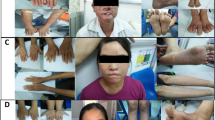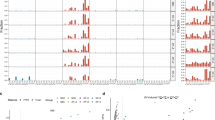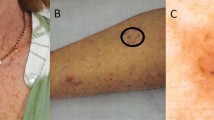Abstract
XERODERMA pigmentosum (XP), a genetically heterogeneous human disease, results from a defect in nucleotide excision repair of ultraviolet-damaged DNA. XP patients are extremely sensitive to sunlight and suffer from a high incidence of skin cancers. Cell fusion studies have identified seven XP complementation groups, A–G1–3. Group D is of particular interest as mutations in this gene can also cause Cockayne's syndrome and trichothiodystrophy4. The XPD gene was initially named ERCC2 (excision repair cross complementing) as it was cloned using human DNA to complement the ultraviolet sensitivity of a rodent cell line5. We have purified the XPD protein to near homogeneity and show that it possesses single-stranded DNA-dependent ATPase and DNA helicase activities. We tested whether XPD can substitute for its yeast counterpart RAD3, which is essential for excision repair and for cell viability6. Expression of the XPD gene in Saccharomyces cerevisiae can complement the lethality defect of a mutation in the RAD3 gene6, suggesting that XPD is an essential gene in humans.
This is a preview of subscription content, access via your institution
Access options
Subscribe to this journal
Receive 51 print issues and online access
$199.00 per year
only $3.90 per issue
Buy this article
- Purchase on Springer Link
- Instant access to full article PDF
Prices may be subject to local taxes which are calculated during checkout
Similar content being viewed by others
References
Cleaver, J. E. & Kraemer, K. H. in The Metabolic Basis of inherited Disease (eds Scriver, C. R., Beaudet, A. L., Sly, W. S. & Valle, D.) 2949–2971 (McGraw-Hill, New York, 1989).
De Weerd-Kasteline, E. A., Keijzer, W. & Bootsma, D. Nature 238, 80–83 (1972).
Vermeulen, W., Stefanini, M., Giliani S., Hoeijmakers, J. H. & Bootsma, D. Mutat. Res. 255, 201–208 (1991).
Johnson, R. T. & Squires, S. Mutat. Res. 273, 97–118 (1992).
Weber, C. A., Salazar, E. P., Stewart, S. A. & Thompson, L. H. EMBO J. 9, 1437–1447 (1990).
Prakash, S., Sung, P. & Prakash, L. in The Eukaryotic Nucleus (eds Strauss, P. R. & Wilson, S. H.) 275–292 (Telford. Caldwell. New Jersey, 1990).
Matson, S. W., Kaiser-Rogers, K. A. A. Rev. Biochem. 59, 289–329 (1990).
Sung, P., Prakash, L., Matson, S. W. & Prakash, S. Proc. natn. Acad. Sci. U.S.A. 84 8951–8955 (1987).
Wilcox, D. R. & Prakash, L. J. Bact. 148, 618–623 (1981).
Sung, P., Higgins, D., Prakash, L. & Prakash, S. EMBO J. 7, 3263–3269 (1988).
Bunick, D., Zandomeni, R., Ackerman, S. & Weinman, R. Cell 29, 877–886 (1982).
Sawadago, M. & Roeder, R. G. J. biol. Chem. 259, 5321–5326 (1984).
Feaver, W. J., Gileadi, O., Li, Y. & Komberg, R. D. Cell 67, 1223–1230 (1991).
Conaway, R. C. & Canaway, J. W. Proc. natn. Acad. Sci. U.S.A. 86, 7356–7360 (1989).
Schaeffer, L. et al. Science 260, 58–63 (1993).
Gulyas, K. D. & Donahue, T. F. Cell 69, 1031–1042 (1992).
Park, E. et al. Proc. natn. Acad. Sci. U.S.A. 89, 11416–11420 (1992).
Author information
Authors and Affiliations
Rights and permissions
About this article
Cite this article
Sung, P., Bailly, V., Weber, C. et al. Human xeroderma pigmentosum group D gene encodes a DMA helicase. Nature 365, 852–855 (1993). https://doi.org/10.1038/365852a0
Received:
Accepted:
Issue Date:
DOI: https://doi.org/10.1038/365852a0
This article is cited by
-
COL4A1, negatively regulated by XPD and miR-29a-3p, promotes cell proliferation, migration, invasion and epithelial–mesenchymal transition in liver cancer cells
Clinical and Translational Oncology (2021)
-
Ribosomal protein S3 associates with the TFIIH complex and positively regulates nucleotide excision repair
Cellular and Molecular Life Sciences (2021)
-
XPD suppresses cell proliferation and migration via miR-29a-3p-Mdm2/PDGF-B axis in HCC
Cell & Bioscience (2019)
-
TFIIE orchestrates the recruitment of the TFIIH kinase module at promoter before release during transcription
Nature Communications (2019)
-
A Comprehensive Meta-analysis of Genetic Associations Between Key Polymorphic Loci in DNA Repair Genes and Glioma Risk
Molecular Neurobiology (2017)
Comments
By submitting a comment you agree to abide by our Terms and Community Guidelines. If you find something abusive or that does not comply with our terms or guidelines please flag it as inappropriate.



